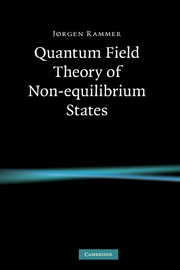Book contents
- Frontmatter
- Contents
- Preface
- 1 Quantum fields
- 2 Operators on the multi-particle state space
- 3 Quantum dynamics and Green's functions
- 4 Non-equilibrium theory
- 5 Real-time formalism
- 6 Linear response theory
- 7 Quantum kinetic equations
- 8 Non-equilibrium superconductivity
- 9 Diagrammatics and generating functionals
- 10 Effective action
- 11 Disordered conductors
- 12 Classical statistical dynamics
- Appendices
- Bibliography
- Index
3 - Quantum dynamics and Green's functions
Published online by Cambridge University Press: 24 December 2009
- Frontmatter
- Contents
- Preface
- 1 Quantum fields
- 2 Operators on the multi-particle state space
- 3 Quantum dynamics and Green's functions
- 4 Non-equilibrium theory
- 5 Real-time formalism
- 6 Linear response theory
- 7 Quantum kinetic equations
- 8 Non-equilibrium superconductivity
- 9 Diagrammatics and generating functionals
- 10 Effective action
- 11 Disordered conductors
- 12 Classical statistical dynamics
- Appendices
- Bibliography
- Index
Summary
In the previous chapter we studied the kinematics of many-body systems, and the form of operators representing the physical properties of a system, all of which were embodied by the quantum field. In this chapter we shall study the quantum dynamics of many-body systems, which can also be embodied by the quantum fields. We shall employ the fact that the quantum dynamics of a system, instead of being described in terms of the dynamics of the states or the evolution operator, i.e. as previously done through the Schrödinger equation, can instead be carried by the quantum fields. The quantum dynamics is therefore expressed in terms of the correlation functions or Green's functions of the quantum fields evaluated with respect to some state of the system. In particular we shall consider the general case of quantum dynamics for arbitrary non-equilibrium states. After introducing various types of Green's functions and relating them to measurable quantities, we will discuss the simplifications reigning for the special case of equilibrium states.
Quantum dynamics
Quantum dynamics can be described in different ways since quantum mechanics is a linear theory and the dynamics described by a unitary transformation of states. This will come in handy in the next chapter when we study a quantum theory in terms of its perturbative expansion using the so-called interaction picture. Here we first discuss the Schrödinger and Heisenberg pictures.
The Schrödinger picture
Having the Hamiltonian on the multi-particle space at hand we can consider the dynamics described in the multi-particle space.
- Type
- Chapter
- Information
- Quantum Field Theory of Non-equilibrium States , pp. 53 - 78Publisher: Cambridge University PressPrint publication year: 2007



